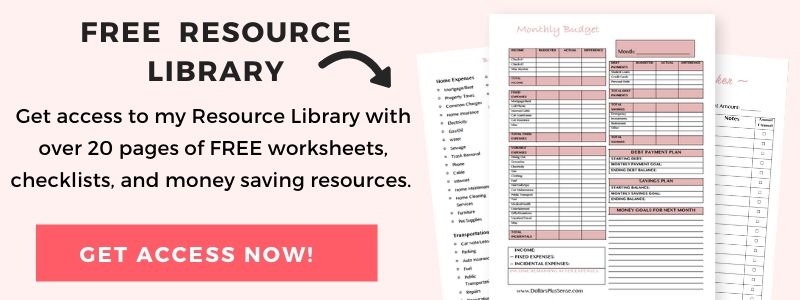Last Updated September 17, 2020
I love to invest in real estate because it is a great investment that can help build true wealth over time. Investing in real estate is a technique that I have used to help me achieve financial freedom more quickly, and I think it can be beneficial to you also. In this real estate investing guide, I will show you 3 simple steps you can take to successfully invest in real estate.
Real Estate Investing Guide
Step 1: Get Educated
The first part of this real estate investing guide is to get educated. Without first getting educated on how to invest in real estate, you are at a much higher risk of failing and making bad deals.
You can start your real estate education by reading books, reading blogs, listening to podcasts, and getting a mentor. Check out my FREE Resource Library where I recommend some good books to improve your real estate education.
Books
Some of the following books I think are a must-read are:

- What Every Real Estate Investor Needs to Know About Cash Flow…And 36 Other Key Financial Measures by Frank Gallinelli;

- The Millionaire Real Estate Investor by Gary Keller and Dave Jenks; and

- The ABCs of Real Estate Investing (Rich Dad’s Advisors) by Ken McElroy.
I have personally read and purchased these books myself, so I highly recommend them.
Blogs
A great real estate investing blog I recommend is BiggerPockets.com. It has a lot of resources and tools you can use for FREE.
They also have a great online community where you can ask other real estate investors questions you may have which is a great resource as a newbie. I find most of the people that are a part of this online community genuinely want to help you and enjoy sharing what they know.
This is also a great place to start if you want to find a mentor because there are a lot of online forums and meet up groups that post time and location of the meet up on this website. However, I find the easiest way to find a mentor is to go out and network with other like-minded investors.
Podcasts
Some of the real estate investing podcasts that I like to listen to are:
- Real Estate Investing For Cash Flow with Kevin Bupp;
- Passive Real Estate Investing with Marco Santarelli; and
- FlipNerd – The Real Estate Investing Show.
BiggerPockets also has a podcast if you want to check that out as well; but I mainly listen to the three listed above.

By getting more educated you are putting yourself in a better position to succeed because you can easily run numbers and recognize a good deal. But even when you become a more seasoned real estate investor, you should never stop learning!
Step 2: Choose Your Investment Category
The next part of this real estate investing guide is you have to choose your investment category. Once you get more educated on real estate investing, you can then choose your investment niche.
There are so many ways you can invest in real estate. It is important to decide what investment niche will best suit your personality if you want to be successful. Some real estate investment categories are:
Raw Land
Raw land is basic land that has not been developed yet. Some investors buy land with the hopes that the land will appreciate due to development nearby or maybe even rezoning. You can also lease land for cash flow or subdivide it for profit.
Single-Family Homes

Single-family homes are probably the most common investments for first-time investors because it is so easy to rent and finance. I first started with this strategy. When I moved out of my condo, I decided to rent it out.
Small Multifamily Homes
Small multifamily homes are properties that usually contain 2-4 units under one roof.
I also currently invest in small multifamily homes. They usually cash flow better than single-family homes because you have multiple streams of income and the vacancy rate is lower.
In other words, if a tenant moves out of a single-family home, your vacancy rate at the time is 100%. If a tenant moves out of a two-family home, your vacancy rate at the time is 50%.
Small multifamily homes are also great because it is easy to finance like a single-family house. Therefore making qualifying for a loan much easier.
Small Apartments
Small apartment buildings are made up of between 5 to 50 units. These properties can be more difficult to finance than single-family and small multifamily homes because they fall under commercial lending standards instead of residential ones.
Instead of being priced based on similar buildings (also known as comps), the value of these properties are based on the income they bring in.
Large Apartments
Large apartment buildings are usually made up of more than 50 units. These properties usually cost millions of dollars to purchase, but can produce good returns with minimal personal involvement.
Commercial

Commercial real estate is property that is leased to a business. The benefits of investing in commercial real estate is there is usually less maintenance required by the owner and consistent rent payments; however, the downside is they have a much longer holding period during vacancies.
Tax Liens
When homeowners do not pay their property taxes, the government can place a tax lien on their property.
The government then can sell those liens to private investors for the amount of taxes owed. The government gets its cash immediately, and the buyer gets the right to collect the delinquent tax, a penalty, and interest on the late payment.
If the property owner doesn’t pay the property taxes by the end of the redemption period, the investor (lienholder) can initiate foreclosure proceedings to take ownership of the property.
REITs
A REIT is when a corporation (or trust) uses investors’ money to purchase and operate income-producing properties.
REITs are traded like stocks. The property generates income which is then paid out to shareholders in the form of dividends. REITs must payout at least 90 percent of their taxable income to shareholders.
Investing in REITs is a good alternative if you would like to have a more hands-off approach but would still like to invest in real estate. However, the returns are usually not as good as hands-on investing.

Note, there are other real estate niche choices that you can consider investing in, but I only listed some of the more popular ones above.
As a beginner, I recommend focusing on one or two specific ways to invest in real estate. That way you become more knowledgeable and better at it. You can always expand later once you gain more experience and knowledge.
Step 3: Choose Your Investment Strategy
The last part of this real estate investing guide is to choose your investment strategy. Once you get more educated on real estate investing, and choose one or two investment niches that fit your personality, you can now focus on your investment strategy.
There are multiple ways you can invest in real estate. It is important to decide what investment strategy will work best with your investment niche if you want to be successful.
Some real estate investment strategies are:
Buy and Hold
Buy and hold is when you buy a property and rent it out to tenants. I use the buy and hold technique when I invest in real estate because of the monthly cash flow.
The owner is responsible for paying the mortgage, taxes, and costs of maintaining the property. Besides paying for expenses, you have to properly select tenants and manage the property adequately.
Buy and Flip

When you buy and flip, you’re purchasing a house that needs repair, and you fix it up before reselling it for a profit.
Another method of buy and flip is you can buy low and sell high in a short period of time. This technique works in a rapidly rising market.
One of the key aspects of flipping a house is speed. You maximize your profits if you can flip quickly. Flipping quickly will reduce your carrying costs such as financing charges, property taxes, utilities, and maintenance fees.
Wholesaling
Wholesaling is finding a great real estate deal, going under contract to secure the deal, and then selling your rights under the contract to another buyer for a fee.
Technically, a wholesaler never actually owns the piece of property they’re selling. Since the wholesaler never actually owned the property, there are usually low costs and other complications.
Summary
Now that we have come to the end of this real estate investing guide, one of the most important things to learn is how to evaluate deals and opportunities. This is important regardless of your investment strategy, and that’s why educating yourself is so important.
Learning how to invest in real estate can take time. So don’t worry if you don’t know exactly what strategy you want to use yet—go at your own pace. Just start by educating yourself so you can be successful and make the best decision for you.
If you are saving for your first deal, I recommend you use my FREE Savings Tracker. It’s a great way to visualize your goal so you can work towards it every day.
Related Articles:
- 5 Great Reasons To Invest In Real Estate
- Best Ways To Start Investing For Beginners: Investing 101
- How I Saved $300,000 In 4 Years
If you want to remember this article, pin it to your favorite Pinterest board.









Great read and valuable information I will look into!
Thanks for reading!